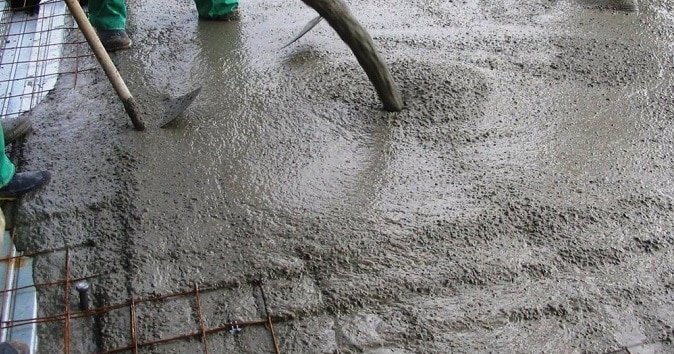High performance concrete (HPC)
High-performance concrete possesses better properties and strength than typical concrete. High-Performance concrete mixtures are highly durable, and they have high ultimate strength. HPC has been used in tunnels, bridges, and tall building structures. Also, in shotcrete repairs, parking garage, and agricultural applications. ACI defined high-performance concrete as a concrete meeting special combinations of performance and uniformity requirements that cannot always be achieved routinely using conventional constituents and normal mixing, placing, and curing practice.
High-performance concrete mixtures developed for a specific application. The characteristics of high-performance concrete are developed to suit the specific application. Some of the properties that may be required include:
• High strength
• High early strength
• High modulus of elasticity
• High abrasion resistance
• High durability and long life in severe environments
• Low permeability and diffusion
• Resistance to chemical attack
• High resistance to frost and deicer scaling damage
• Toughness and impact resistance
• Volume stability
• Ease of placement
• Compaction without segregation
• Inhibition of bacterial and mold growth
The ingredients of HPC are similar to normal concrete. HPC consists of cement, aggregates, water, mineral admixtures, and chemical admixtures. The used cement should develop the required strength within the expected time. Also, it should facilitate appropriate rheological characteristics for the fresh concrete. The used cement should be compatible with the chemical admixture. Studies have shown that cement with a lower amount of C3A will improve fresh concrete rheological properties. Certainly, the w/c for HPC is lower than normal concrete, and it ranges from 0.20-0.45.
The size of aggregates playing an important role in determining of concrete strength. The smaller size of aggregates should be used to produce concrete with higher strength. Concrete with a compressive strength of 70 MPa can be produced by using suitable coarse aggregates with a maximum size of 20 to 28 mm. 10-14 mm maximum size of aggregate should be used to produce concrete with a compressive strength of 125 Mpa.
Mineral admixtures such as silica fume, GGBS, and fly ash are used to improve concrete properties. These pozzolans can improve concrete compressive strength, abrasion resistance, reducing permeability, and improving workability. Also, the using of pozzolans will contribute in saving environment resources by reducing the amount of cement and reusing other industries by-products.
Chemical admixtures are used to improve the properties of HPC. Using chemical admixture is compulsory, superplasticizer, water reducer, and retards are used for HPC. The using of Air-entraining admixture is necessary when the freeze and thaw cycles will threaten concrete durability.
The HPC possess a low permeability, lower permeability will protect the concrete from an aggressive chemical such as chloride and sulfate, which enhance concrete durability and protect steel from corrosion. In addition to low permeability, HPC will possess good resistance to freeze and thaw cycles in a cold environment. Also, HPC has good resistance to carbonation.
• High strength
• High early strength
• High modulus of elasticity
• High abrasion resistance
• High durability and long life in severe environments
• Low permeability and diffusion
• Resistance to chemical attack
• High resistance to frost and deicer scaling damage
• Toughness and impact resistance
• Volume stability
• Ease of placement
• Compaction without segregation
• Inhibition of bacterial and mold growth
The ingredients of HPC are similar to normal concrete. HPC consists of cement, aggregates, water, mineral admixtures, and chemical admixtures. The used cement should develop the required strength within the expected time. Also, it should facilitate appropriate rheological characteristics for the fresh concrete. The used cement should be compatible with the chemical admixture. Studies have shown that cement with a lower amount of C3A will improve fresh concrete rheological properties. Certainly, the w/c for HPC is lower than normal concrete, and it ranges from 0.20-0.45.
The size of aggregates playing an important role in determining of concrete strength. The smaller size of aggregates should be used to produce concrete with higher strength. Concrete with a compressive strength of 70 MPa can be produced by using suitable coarse aggregates with a maximum size of 20 to 28 mm. 10-14 mm maximum size of aggregate should be used to produce concrete with a compressive strength of 125 Mpa.
Mineral admixtures such as silica fume, GGBS, and fly ash are used to improve concrete properties. These pozzolans can improve concrete compressive strength, abrasion resistance, reducing permeability, and improving workability. Also, the using of pozzolans will contribute in saving environment resources by reducing the amount of cement and reusing other industries by-products.
Chemical admixtures are used to improve the properties of HPC. Using chemical admixture is compulsory, superplasticizer, water reducer, and retards are used for HPC. The using of Air-entraining admixture is necessary when the freeze and thaw cycles will threaten concrete durability.
The HPC possess a low permeability, lower permeability will protect the concrete from an aggressive chemical such as chloride and sulfate, which enhance concrete durability and protect steel from corrosion. In addition to low permeability, HPC will possess good resistance to freeze and thaw cycles in a cold environment. Also, HPC has good resistance to carbonation.
















Comments
Post a Comment